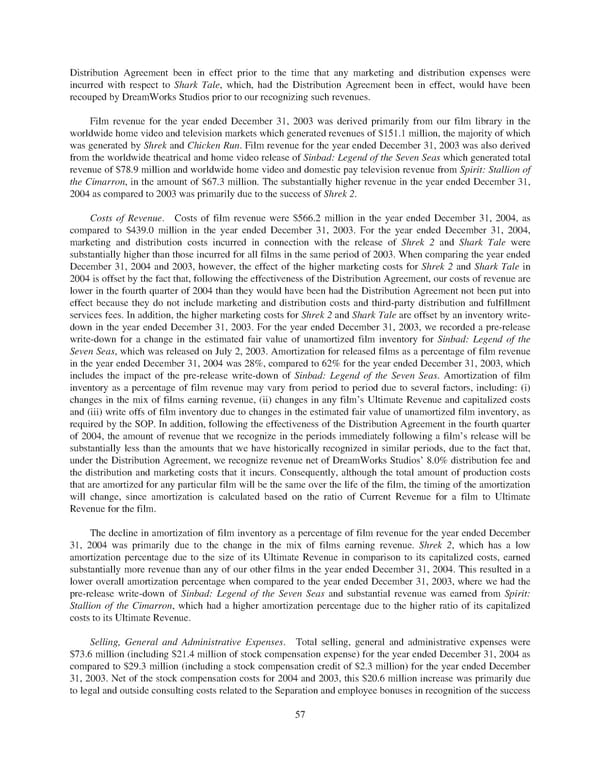Distribution Agreement been in effect prior to the time that any marketing and distribution expenses were incurred with respect to Shark Tale, which, had the Distribution Agreement been in effect, would have been recouped by DreamWorks Studios prior to our recognizing such revenues. Film revenue for the year ended December 31, 2003 was derived primarily from our film library in the worldwide home video and television markets which generated revenues of $151.1 million, the majority of which was generated by Shrek and Chicken Run. Film revenue for the year ended December 31, 2003 was also derived from the worldwide theatrical and home video release of Sinbad: Legend of the Seven Seas which generated total revenue of $78.9 million and worldwide home video and domestic pay television revenue from Spirit: Stallion of the Cimarron, in the amount of $67.3 million. The substantially higher revenue in the year ended December 31, 2004 as compared to 2003 was primarily due to the success of Shrek 2. Costs of Revenue. Costs of film revenue were $566.2 million in the year ended December 31, 2004, as compared to $439.0 million in the year ended December 31, 2003. For the year ended December 31, 2004, marketing and distribution costs incurred in connection with the release of Shrek 2 and Shark Tale were substantially higher than those incurred for all films in the same period of 2003. When comparing the year ended December 31, 2004 and 2003, however, the effect of the higher marketing costs for Shrek 2 and Shark Tale in 2004 is offset by the fact that, following the effectiveness of the Distribution Agreement, our costs of revenue are lower in the fourth quarter of 2004 than they would have been had the Distribution Agreement not been put into effect because they do not include marketing and distribution costs and third-party distribution and fulfillment services fees. In addition, the higher marketing costs for Shrek 2 and Shark Tale are offset by an inventory write- down in the year ended December 31, 2003. For the year ended December 31, 2003, we recorded a pre-release write-down for a change in the estimated fair value of unamortized film inventory for Sinbad: Legend of the Seven Seas, which was released on July 2, 2003. Amortization for released films as a percentage of film revenue in the year ended December 31, 2004 was 28%, compared to 62% for the year ended December 31, 2003, which includes the impact of the pre-release write-down of Sinbad: Legend of the Seven Seas. Amortization of film inventory as a percentage of film revenue may vary from period to period due to several factors, including: (i) changes in the mix of films earning revenue, (ii) changes in any film’s Ultimate Revenue and capitalized costs and (iii) write offs of film inventory due to changes in the estimated fair value of unamortized film inventory, as required by the SOP. In addition, following the effectiveness of the Distribution Agreement in the fourth quarter of 2004, the amount of revenue that we recognize in the periods immediately following a film’s release will be substantially less than the amounts that we have historically recognized in similar periods, due to the fact that, under the Distribution Agreement, we recognize revenue net of DreamWorks Studios’ 8.0% distribution fee and the distribution and marketing costs that it incurs. Consequently, although the total amount of production costs that are amortized for any particular film will be the same over the life of the film, the timing of the amortization will change, since amortization is calculated based on the ratio of Current Revenue for a film to Ultimate Revenue for the film. The decline in amortization of film inventory as a percentage of film revenue for the year ended December 31, 2004 was primarily due to the change in the mix of films earning revenue. Shrek 2, which has a low amortization percentage due to the size of its Ultimate Revenue in comparison to its capitalized costs, earned substantially more revenue than any of our other films in the year ended December 31, 2004. This resulted in a lower overall amortization percentage when compared to the year ended December 31, 2003, where we had the pre-release write-down of Sinbad: Legend of the Seven Seas and substantial revenue was earned from Spirit: Stallion of the Cimarron, which had a higher amortization percentage due to the higher ratio of its capitalized costs to its Ultimate Revenue. Selling, General and Administrative Expenses. Total selling, general and administrative expenses were $73.6 million (including $21.4 million of stock compensation expense) for the year ended December 31, 2004 as compared to $29.3 million (including a stock compensation credit of $2.3 million) for the year ended December 31, 2003. Net of the stock compensation costs for 2004 and 2003, this $20.6 million increase was primarily due to legal and outside consulting costs related to the Separation and employee bonuses in recognition of the success 57
 DreamWorks Annual Report Page 62 Page 64
DreamWorks Annual Report Page 62 Page 64